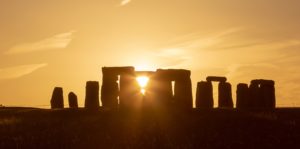
Every June hundreds of people gather at Stonehenge in Wiltshire, England to celebrate the longest day of the day. The day marks the point where the sun is the furthest from the equator, and so the northern hemisphere experiences a long day of sunlight. Since the Neolithic era, the summer solstice marked a crucial point in the year for farmers, herders, and pastoralists as it sees the start of new crop cycles. However, the day is linked to some key traditions and folklore festivities which are celebrated across the northern hemisphere.
The most notable celebration in England is the gathering at Stonehenge, which every year is attended by hundreds of people to witness the sunrise perfectly align with the stones. The entire design of Stonehenge is based around the changing seasons with the mid-summer and mid-winter solstices aligning across the site. On the summer solstice, or the summer equinox, the sunrises to the left of the Heelstone which sits on the outlying north-east circle of the site. Archaeologists have found a large stone hole next to the Heelstone which is believed to be where a partner stone may have sat which would have framed the sunrise between these two stones perfectly. Then on mid-winter’s day, the sun sets between the two upright stones of the tallest trilithon and drops down over the Altar stone. However, today much of the trilithon has fallen, but through laser scans of Stonehenge, it is believed that these stones were carefully constructed to frame the movement of the sun. Therefore, Stonehenge has become a site for great celebration, particularly for pagans and druids, as it marks out the extreme movements of the sun through its solstices and so the shift into a new season is celebrated.
Traditions celebrating the summer solstice extend back to the Neolithic era but are still celebrated today in a variety of ways across the world. Across the northern hemisphere the summer solstice is celebrated by lighting bonfires thought to boost the sun’s strength for the remainder of the crop season and ensure a healthy harvest. We see crucial bonfire festivals across countries such as Finland and Norway. However, celebrations of the summer solstice are not just limited to the Western World, as many ancient cultures and communities had their own unique traditions which centres around mid-summer and the celebration of deities. In ancient Egypt, the summer solstice aligned with the rise of the River Nile, so Ra, the deity of the Sun was worshipped. We can see Ra’s depiction on pyramid steles with a falcon’s head and a sun disk. Therefore, worshipping the sun and the role the summer solstice plays across the world can be seen throughout history.
However, much of the summer solstice traditions are rooted in folklore, as pre-Christian festivities focused on mystical creatures. It is said that on the summer solstice magic is meant to be at its strongest, with the myth of the world turning upside down or that the sun is standing still for the day allowing an abundance of magical power. Before Christian pagan customs, bonfires were meant to keep demons away and bring good luck to lovers. Therefore, the summer solstice has a clear folklore history in the world of magic and the mystical, however, much of this seems to have been lost today.
Overall, the summer solstice symbolises for many the start of summer as we experience the longest day of the year. The history of the summer solstice is rich with religious, spiritual and folklore traditions that mark this key day across the northern hemisphere. Whether you only know about Midsummer from Shakespeare’s A Midsummer Night Dream, or have plans to attend Stonehenge very soon, the day symbolises a change in season and with that, we can only hope for a refreshing shift to see us through until the winter solstice.







